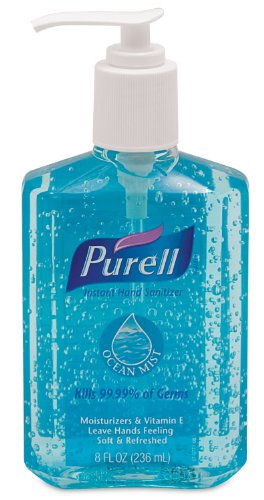Tuesday, January 24, 2012
Tuesday, January 17, 2012
Hand Sanitizer
Hand sanitizers claim to kill ~99% of bacteria. How does this work? Well, alcohol kills bacteria exponentially. For example, after x amount of time, 90% are dead. After 2x that time, 99%, 3x, 99.9%, and so on. As you can see from that math, you'll never 100% sterilize something using alcohol - at least not in a practical way. However, as far as getting germs off your hands, 99.9% is good enough. You're not looking to sterilize your hands (which is impossible), you're looking to cut down the risk of infection.
The 10% survivors in each instance aren't resistant, they're just lucky. Maybe they didn't get the full exposure to the alcohol, they had a little extra water in them, or they were in a clump. The effectiveness of a sanitizer is always dependent on the surface to which it is applied. If the alcohol can't get to the bacterium, it can't kill it. As such, human skin provides a lot of nooks and crannies in which bacteria could not be reached by the alcohol very well. This is why alcohol based hand rubs are only recommended on non-soiled hands. They aren't designed to penetrate dirt and gunk. Just like the ratio of bleach to water has to increase depending on the amount of blood (or protein) in a spill.
Also, while alcohol kills everything, it doesn't efficiently kill everything. Bacterial spores, bacteria with thick capsules, and nonenveloped viruses are fairly resistant to alcohol. For this reason, alcohol is never used as the only method when something needs to be completely sterile - we use fire, 10% bleach, formaldehyde, gamma rays, or autoclaving instead. Labs also use the aseptic technique when surfaces need to be 100% sterile. Please see the CDC take on handwashing and hand sanitizer.
Saturday, January 7, 2012
Methuselah
Methuselah is the oldest known living non-colonal organism in the world. It is 4,842 years old. It can be found in the Bristlecone Pine Forest near Death Valley. However, while it is open to tourists, nowhere does it say which tree is Methuselah; it's kept anonymous for its own security. According to the Wikipedia page, " Methuselah's exact location is undisclosed as a protection against vandalism." So while unlikely that the tree above is Methuselah, it is probably very similar to this one.
In 1964, when scientists were first beginning to realize just how old these trees were, they decided to do some core sampling. A graduate student doing the samples ended up getting his drill bit stuck in one of the trees. Rather than just leave it there, he decided to cut down the tree to retrieve it. Upon inspecting the age rings of said tree, it became apparent that the tree, nicknamed Prometheus, was well over 5,000 years old. This controversial felling is featured in an episode of Radiolab, appropriately titled "Oops."
Sunday, January 1, 2012
Subscribe to:
Posts (Atom)


